May 29, 2006
David and I are about to embark on the long journey home–36 hours to Beijing, then 15 or so hours in the air, a four hour bus ride to Bloomington–then a campout this coming weekend.
We have been trying to figure out what is special about this trip.
Here are some thoughts about Henan, China’s most populous province (with 100 m people!).
1) Unlike our trips with students, this was not prepackaged to visit with other tour groups at restaurants, or even to visit factories (followed by a factory outlet store to give you the opportunity–in case you missed it–to purchase the tchotchkes that everyone purchases their first time in China). Indeed, our guide has picked restaurants for us where we have gone in as the only ones from out of town–and had little children point to us and describe us to their parents as foreigners (they may be from out of town, too). We have not been to a factory–perhaps because Zhengzhou’s largest factory sells busses, and they are difficult to get back home.
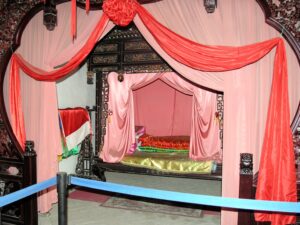 1a) To be rich is indeed glorious, no matter which country. We stopped here at an estate where Cu Xi fled in 1900 when the 8 nations occupied Beijing. It had some really neat furniture, including a bedroom fit for royalty.
1a) To be rich is indeed glorious, no matter which country. We stopped here at an estate where Cu Xi fled in 1900 when the 8 nations occupied Beijing. It had some really neat furniture, including a bedroom fit for royalty.
2) There are not large crowds in this area of China–not of tourists, anyway. We had dinner with our guide’s boss, the number one English- speaking guide in China, and he told us that he has been to SE Asia to promote Henan 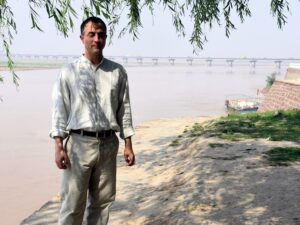 tourism to overseas Chinese. “Why would people come here,” I asked. His reply, “it’s the birthplace of Chinese history.” Here, near the Yellow River, were located five of the ancient dynasties, and 12 of the 27 modern ones (aren’t you glad you have to memorize only 40 presidents!).
tourism to overseas Chinese. “Why would people come here,” I asked. His reply, “it’s the birthplace of Chinese history.” Here, near the Yellow River, were located five of the ancient dynasties, and 12 of the 27 modern ones (aren’t you glad you have to memorize only 40 presidents!).
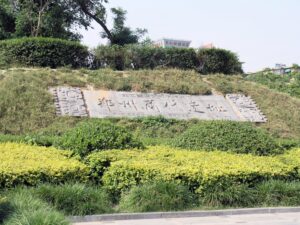
 He’s right–we’ve seen lots of history, beginning here in Zhengzhou with the remains of the Shang dynasty town wall–about 1700 BC. We’ve been in the museum here and in Luoyang, and I think I’d be afraid to dig anywhere around the province because we’d probably dig up some priceless tomb with priceless artifacts.
He’s right–we’ve seen lots of history, beginning here in Zhengzhou with the remains of the Shang dynasty town wall–about 1700 BC. We’ve been in the museum here and in Luoyang, and I think I’d be afraid to dig anywhere around the province because we’d probably dig up some priceless tomb with priceless artifacts.
 On the way here from Luoyang, we visited the Shaolin monastery, home of the Kung Fu monks. In the Sung dynasty, they saved the emperor, and thus the monastery—on one of the sacred hills in China–has the rank of number one monastery. We saw a wonderful exhibition of kung fu by some of the 16,000 students enrolled there. Unfortunately, the monks could
On the way here from Luoyang, we visited the Shaolin monastery, home of the Kung Fu monks. In the Sung dynasty, they saved the emperor, and thus the monastery—on one of the sacred hills in China–has the rank of number one monastery. We saw a wonderful exhibition of kung fu by some of the 16,000 students enrolled there. Unfortunately, the monks could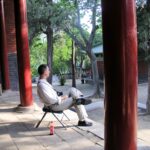 not save the monastery in 1928, when one of the warlords, suspecting his enemies were hiding in it, burned it down. There is one original building, and a whole lot of others that have been rebuilt to specifications and pictures, so you would never know they were replacements.
not save the monastery in 1928, when one of the warlords, suspecting his enemies were hiding in it, burned it down. There is one original building, and a whole lot of others that have been rebuilt to specifications and pictures, so you would never know they were replacements.
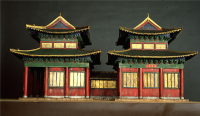
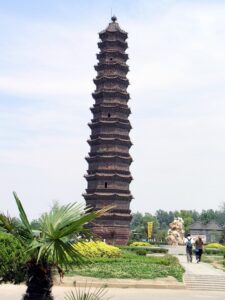 Kaifeng used to be the big city of the province. It was the capital of the Northern Sung, around 900 years ago. War and revolution–and the love-hate relationship the Chinese have with the Yellow River (in the 1930s, to block the advance of the Japanese, Chiang Kai-shek opened the dikes near here and flooded much of the countryside, killing almost a million Chinese) leveled the city over the centuries. There’s one pagoda left from ancient days, and
Kaifeng used to be the big city of the province. It was the capital of the Northern Sung, around 900 years ago. War and revolution–and the love-hate relationship the Chinese have with the Yellow River (in the 1930s, to block the advance of the Japanese, Chiang Kai-shek opened the dikes near here and flooded much of the countryside, killing almost a million Chinese) leveled the city over the centuries. There’s one pagoda left from ancient days, and 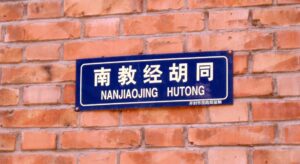 an interesting section of the city called “Torah reading street,” a testimony to the trade that brought Jews from Persia to China. Our guide of the area was a descendant of the Jewish
an interesting section of the city called “Torah reading street,” a testimony to the trade that brought Jews from Persia to China. Our guide of the area was a descendant of the Jewish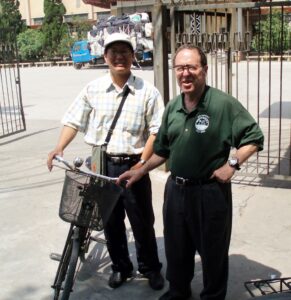 converts, who showed us a picture of the synagogue (long since destroyed) that for all the world looks like the mosque in Xian. Which looks for all the world like a Chinese pagoda!
converts, who showed us a picture of the synagogue (long since destroyed) that for all the world looks like the mosque in Xian. Which looks for all the world like a Chinese pagoda!
3) We went to a Cultural Revolution themed restaurant the other night, where my 1960s Maoisms came in handy. I think it is a measure of how far China 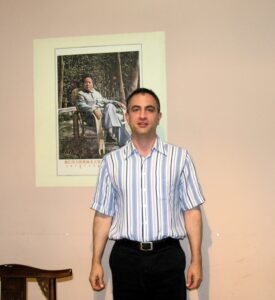 has come that they can poke fun at a terrible time in their history. Last night, to bring closure, on a walk through a Shang dynasty remains park a block from the Holiday Inn where we’re staying, we had an ex-English
has come that they can poke fun at a terrible time in their history. Last night, to bring closure, on a walk through a Shang dynasty remains park a block from the Holiday Inn where we’re staying, we had an ex-English
teacher talk with us and wound up at a jam session with an accordion, singing Chinese and American folk songs. Neat evening.